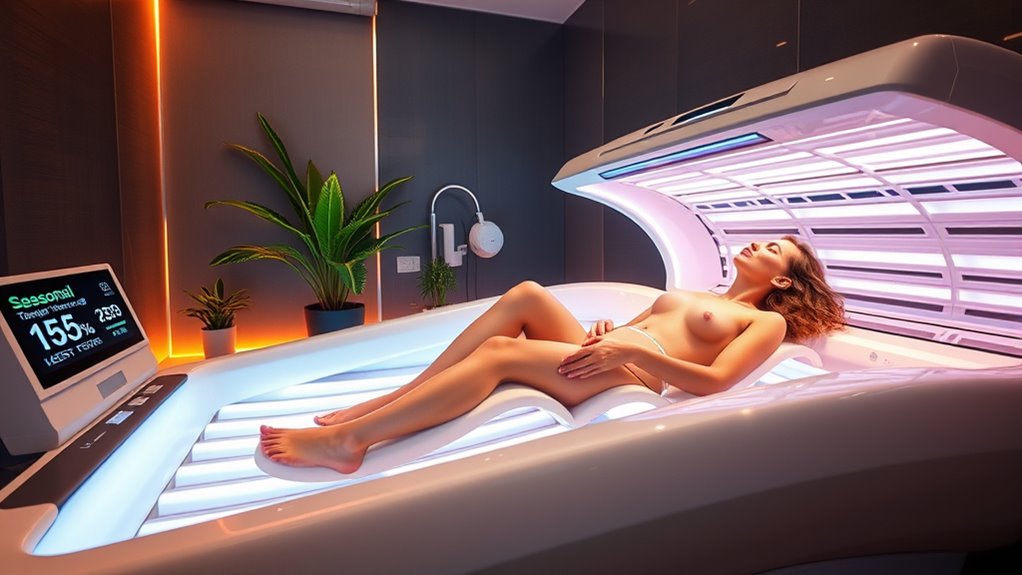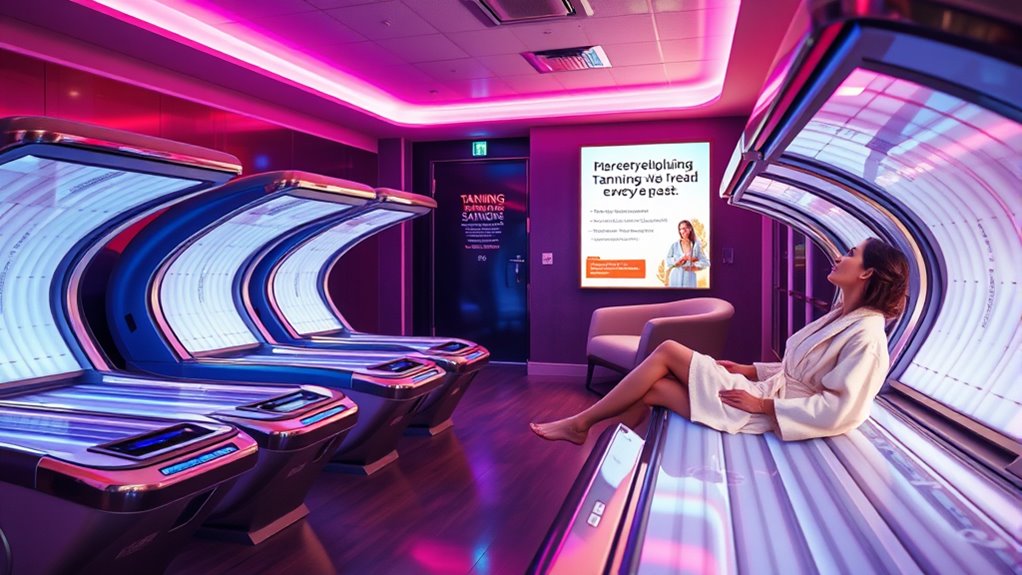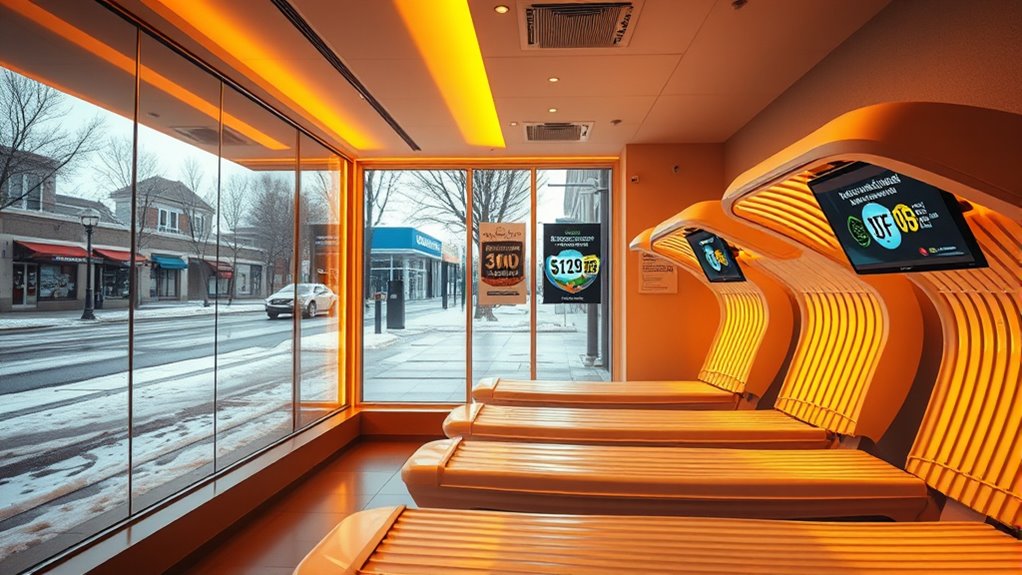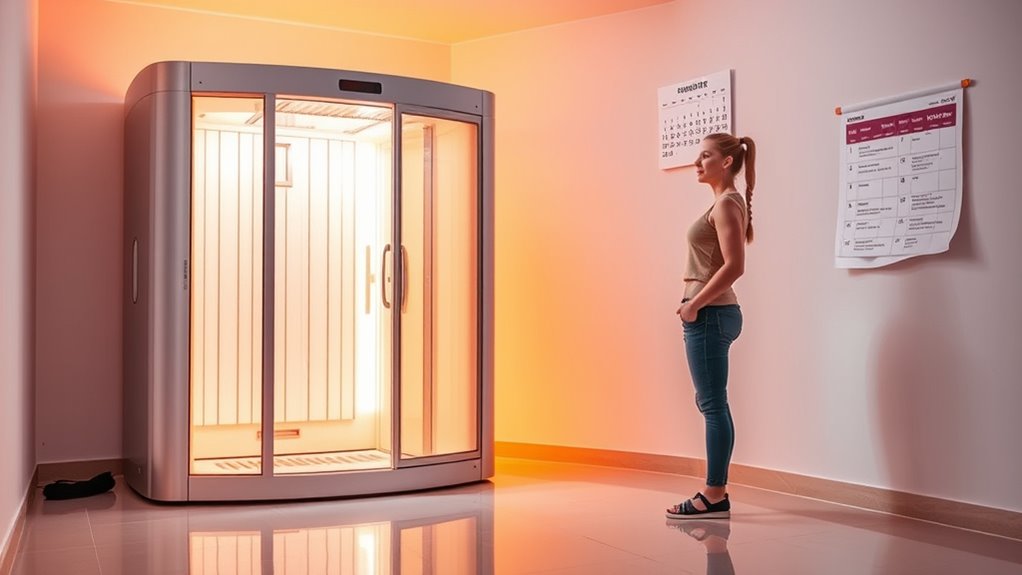Indoor tanning during off-seasons remains popular as many seek to maintain their year-round tan, often influenced by social media trends, peer pressure, and personal preferences. Despite increased awareness of skin cancer risks, regulations, and safety innovations, some still tan outdoors or indoors outside peak sunny months. Business challenges and marketing efforts also keep demand alive throughout the year. To learn more about how these factors shape tanning habits and health implications, keep exploring further.
Key Takeaways
- Indoor tanning often increases during winter months despite reduced natural sunlight, driven by social trends and psychological factors.
- Year-round tanning, including off-season, raises skin cancer risks and accelerates skin aging.
- Regulations and safety protocols influence tanning salon operations and client behavior during off-peak periods.
- Technological innovations offer UV-free tanning alternatives, promoting safer options during off-seasons.
- Public health campaigns target high-risk groups and utilize social media to discourage off-season tanning behaviors.
Understanding Seasonal Tanning Trends and Behavior Patterns

Understanding how seasonal trends influence indoor tanning behavior reveals that many individuals increase their tanning during winter months, despite lower natural sunlight. You might notice that some people maintain tanning routines year-round, while others tend to tan more during specific seasons or social events. Regular tanners often start young, tan more frequently, and develop dependence, unlike seasonal tanners who tan mainly in sun-deprived periods. Many people tan more in winter to compensate for reduced outdoor sun exposure or to prepare for events. Some engage in spontaneous or event-driven tanning outside the usual season. Tanning behaviors are influenced by social norms, personal beliefs, and psychological factors like mood improvement, especially during darker months. Additionally, understanding the psychological factors behind tanning can help explain why some individuals develop dependencies, highlighting the need for awareness and behavioral interventions. Recognizing the indoor tanning industry and its marketing strategies can also shed light on how social influences perpetuate these behaviors. These patterns reflect complex motivations beyond just aesthetics, shaping overall indoor tanning habits throughout the year.
The Impact of Off-Season Tanning on Skin Health and Risks

Many people tan during the off-season, especially in winter, believing it helps maintain a bronzed look or prepares them for upcoming events. However, indoor tanning increases your risk of skin cancer, including melanoma, basal cell carcinoma, and squamous cell carcinoma. UV rays from tanning beds damage your skin, with UVA causing deep tissue damage and UVB leading to sunburn. Starting tanning at a young age notably raises cancer risks. Besides cancer, tanning accelerates skin aging—causing wrinkles, age spots, and leathery texture—making you look older. Vitamin D needs can be met through diet and supplements, eliminating the need for UV exposure. Regulatory warnings and public awareness aim to reduce tanning’s popularity, but many still underestimate the health dangers associated with off-season indoor tanning. High refresh rates in projectors can enhance visual clarity, but they cannot mitigate the skin damage caused by UV exposure during tanning. It is important to recognize that UV exposure from tanning beds can cause immediate skin damage as well as long-term health issues, including skin cancer risk. Additionally, the long-term effects of UV radiation can contribute to other health problems beyond skin cancer.
Furthermore, understanding the mechanisms of UV damage can help in developing better protective strategies to minimize health risks.
How Social Media Influences Tanning Habits Outside Peak Seasons

Ever wonder how social media shapes your tanning habits even outside the peak seasons? Platforms like Instagram and Snapchat use visual messages that make tanning seem normal and desirable, especially among young women. Instagram campaigns target high-risk groups, spreading awareness and misinformation about Vitamin D and tanning risks. Twitter often features posts where young adults express their desire to tan, reinforcing the behavior. Social media also normalizes indoor tanning through pop culture references, making it seem fashionable year-round. Even during off-seasons, misinformation persists, and peer influence from friends online continues to shape attitudes. Trustworthiness of Patchology and other credible brands often remain underrepresented in these conversations, which can influence perceptions of safe tanning practices. Attention plays a crucial role in how individuals process and internalize these messages, impacting their tanning choices. Understanding the Private Placement Equity Market can help public health professionals develop strategies to counteract these influences. Public health efforts must adapt by monitoring online trends and delivering targeted, appearance-based messages to counteract the ongoing influence of social media on tanning habits, regardless of the season. Additionally, understanding tanning behavior can help in developing more effective interventions to reduce harmful practices. Recognizing the role of visual messaging in shaping perceptions can further enhance these strategies.
Regulatory Changes and Their Effect on Year-Round Tanning Practices

Regulatory changes have markedly impacted indoor tanning practices throughout the year, prompting facilities to adjust their operations and pricing strategies. You now need to register with the Department of Health, paying a $150 fee for up to two sunlamps, with additional costs for more equipment. Age restrictions prohibit those under 16 from tanning, while 17-year-olds require parental consent. Regulations emphasize proper equipment maintenance, sanitation, safety protocols, and client education about risks. These rules increase operational costs and influence customer access, especially during off-seasons. Facilities must implement hygiene standards, provide protective eyewear, and inform clients about health risks, which can reduce demand over time. Additionally, understanding the best indoor tanning practices can help facilities maintain safety and customer satisfaction while complying with regulations. Implementing comprehensive training for staff on safety procedures is essential to ensure compliance and protect clients. Staying informed about password security features can help safeguard sensitive client data and uphold trust in the business. Moreover, keeping abreast of regulatory updates is crucial for adapting to evolving legal requirements and maintaining compliance in the industry. Staying current with industry standards can further enhance safety and operational efficiency. Overall, these regulations shape how tanning salons operate year-round, balancing safety requirements with business sustainability.
Economic Factors and Marketing Strategies During Off-Peak Periods

Indoor tanning businesses face significant economic challenges during off-peak seasons, as sales drop and foot traffic slows. You must manage reduced revenue while covering fixed costs like rent and equipment maintenance. Cash flow management becomes critical to stay afloat during these slow periods. Increased competition from self-tanning products adds pressure to attract clients. To counteract these challenges, you can offer promotional discounts and implement loyalty programs that encourage repeat visits. Diversifying services, such as adding non-UV treatments, helps stabilize income. Targeted marketing toward specific groups, like college students, can boost off-season patronage. Participating in community events also raises visibility. Additionally, understanding dog names can inspire creative branding ideas for marketing campaigns. Employing cost control strategies is essential to maintain profitability during slower months. Monitoring seasonal trends enables better planning and resource allocation to adapt proactively. Recognizing consumer behavior patterns can further refine your marketing efforts and improve customer retention. Overall, adapting marketing strategies and managing costs effectively are essential to sustain your business during off-peak times.
Technological Innovations Promoting Safer Tanning Alternatives

Technological innovations are transforming the tanning industry by making safer alternatives more accessible and effective. Modern tanning beds now feature stronger UV filters that block UVB rays while allowing UVA rays, reducing the risk of burns and skin damage. Advanced cooling systems improve comfort during sessions, encouraging safer tanning practices. Smart timers automatically shut off to prevent overexposure, and skin sensing technology tailors UV output based on your skin type, minimizing burns. Wellness features like red light therapy are also integrated to boost skin health and collagen production. Additionally, UV-free options such as spray tans, self-tanning products, and airbrush tanning continue to grow in popularity for their safety and convenience. These innovations help you achieve a tan while prioritizing skin health and safety.
Timing and Planning for Effective Public Health Campaigns

Effective timing and planning are essential to the success of public health campaigns aimed at reducing indoor tanning. You should target high-risk groups like young women and men interested in tanning, delivering clear messages about health risks such as skin cancer. Timing campaigns during peak engagement periods, like before summer or holiday seasons, maximizes impact. Leverage platforms like Instagram and partner with influencers to boost visibility. Allocate resources wisely to ensure broad reach and craft appealing, informative messages that resonate with your audience. Use tools like social media metrics and post-campaign analyses to evaluate effectiveness. Collaborate with organizations and policymakers to strengthen efforts through education, regulations, and countering misinformation. Precise planning and strategic scheduling are key to changing tanning behaviors effectively. Incorporating insights from sound healing science can also inspire innovative approaches to reinforce health messages through calming and engaging methods. Additionally, understanding public health campaign strategies can enhance the overall effectiveness of your outreach efforts. Recognizing the importance of toilet maintenance in public facilities can contribute to overall health promotion, as clean and functional environments encourage positive health behaviors.
Frequently Asked Questions
What Are the Long-Term Skin Health Effects of Off-Season Tanning?
You might think off-season tanning is harmless, but it still damages your skin long-term. UV exposure accelerates aging, causing wrinkles, age spots, and loss of skin elasticity. It also increases your risk of melanoma and other skin cancers. Even if you tan less frequently, the damage adds up over time. Protect your skin by avoiding tanning beds and opting for safer alternatives like self-tanning products to maintain healthier skin in the long run.
How Do Cultural Differences Influence Off-Season Indoor Tanning Habits Globally?
Sure, because everyone loves a year-round tan, right? Cultural differences shape your off-season indoor tanning habits more than you might think. In some places, a tan symbolizes beauty and status, while others prefer lighter skin. Peer pressure, media, and regulations play their part, making tanning a reflection of societal ideals. So, your tanning choices during off-seasons are really a mirror of your culture’s beauty standards and social influences.
Are There Specific Demographic Groups More Likely to Tan During Off-Peak Seasons?
You want to know which groups tend to tan during off-peak seasons. Data shows younger adults, especially women aged 18–29, are most likely to indoor tan year-round, even in winter. Non-Hispanic white women are the primary demographic, often motivated by appearance and mood enhancement. People from northern states and college students in seasonal climates also tend to seek indoor tanning during colder months, driven by limited outdoor sun exposure and seasonal perceptions.
How Effective Are Current Regulations in Reducing Year-Round Indoor Tanning?
Regulations reveal limited, lingering, and often lax limits on indoor tanning, making it tricky to curb year-round tanning habits. You might notice some decline where laws are strong, especially with under-18 bans, but frequent fanners still find ways around restrictions. Weak warnings, scant enforcement, and exceptions like medical exemptions allow persistent, pervasive tanning practices to prevail, undermining efforts to reduce ongoing, all-year indoor tanning behaviors effectively.
What Role Do Online Influencers Play in Promoting Off-Season Tanning?
You should know that online influencers play a significant role in promoting off-season tanning. They often share appealing content, discounts, and holiday-themed offers, encouraging young adults to tan even when it’s not peak season. Their persuasive posts, sometimes spreading misinformation about benefits like vitamin D, influence perceptions and behaviors. By partnering with salons and using social media strategies, influencers help maintain tanning habits year-round, impacting public health efforts to reduce risky behaviors.
Conclusion
As you consider year-round tanning, remember that the sun’s warmth can be both a gift and a gamble. By understanding seasonal trends and staying informed about risks, you hold the power to protect your skin’s future. Like a lighthouse guiding ships safely home, awareness shines a light on healthier choices. Embrace innovations and regulations as your allies, ensuring your tanning habits don’t cast shadows on your well-being.









